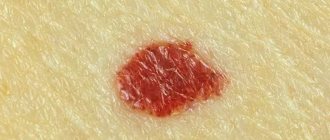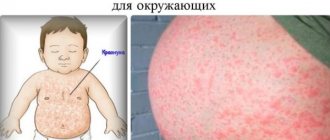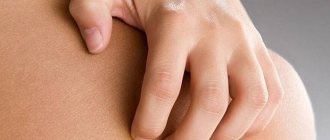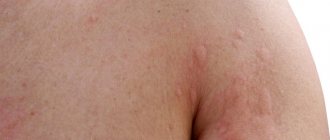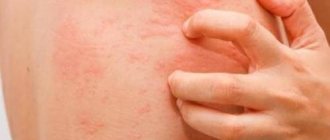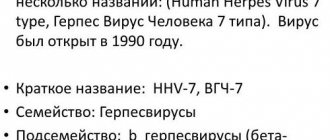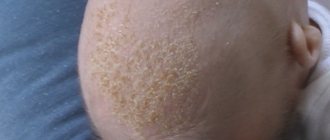What is diathesis
Red cheeks in a baby are not a sign of health, but of an allergic reaction to one or another irritant. Diathesis is a predisposition of a child’s body to pathological reactions to food, household chemicals or other substances. This feature of the child’s body makes him vulnerable to a number of other diseases. Thus, diathesis determines the reactivity of the baby’s organs and systems: when exposed to negative internal or external factors, the baby may develop various pathologies (allergies, metabolic disorders, infectious lesions).
Dry diathesis
The skin disease appears as a red rash that usually appears on the baby's stomach, cheeks, thighs, and back. Dry diathesis lasts for several days and, if the baby’s mother does not pay attention to the symptoms, the baby’s skin begins to dry out. The epidermis quickly peels off, revealing new areas, while the child feels discomfort and irritation. The main danger of dry diathesis appears when the crusts on the baby’s body begin to crack, opening access to infections. In this case, the baby will experience severe discomfort and pain.
Weeping diathesis
The disease manifests itself on the baby’s skin in the form of yellow-gray scaly crusts, which subsequently begin to become wet due to the secretion of lymph. Weeping diathesis in children occurs in infancy and adulthood (the disease affects infants, one-year-old children and even adolescents). The redness shown in the photo lasts a couple of days, after which swellings and blisters filled with water appear at the site of the rash. Later, the blisters burst, exposing the lower layers of skin and causing pain. The process is repeated until the parents cure the child.
Drug therapy for children
If the diathesis continues to progress, its course is prolonged, or you cannot cope with the search for pathogens, you should resort to the help of special medications. Properly selected medications quite quickly alleviate the baby’s condition and help the rash on the arms disappear:
- Restoration of intestinal microflora. When diathesis is detected on the hands, doctors usually prescribe products with bifidobacteria, eubiotics, probiotics, vitamins A, B, K and lipoic acid to the baby. Most often in such cases, Lactobacterin and Linex are used.
- Elimination of dandruff and diaper rash. To do this, damaged areas of the baby's skin and folds are treated with salicylic ointment. It is recommended to apply Vaseline or vegetable oil to the scalp. Treatment sessions should be arranged after bathing.
- Elimination of rashes. How to apply diathesis on a child’s hands? For this, doctors most often recommend products based on zinc oxide. Such preparations help eliminate scratches and accelerate regeneration. For severe rashes, hormonal ointments are used - Flucinar and Advantan. In addition, the pediatrician can prescribe non-steroidal anti-inflammatory and even antibacterial drugs for the baby, for example, Naftaderm or Thymogen.
- To improve the baby's sleep, sedatives can be used - Edas, Phenibut, Citral, Leovit.
- For advanced forms of diathesis, antihistamines are used - Suprastin, Fenistil, Tavegil, Pipolfen.
How does diathesis manifest in infants?
The primary rashes that appear on the baby's body resemble prickly heat. However, even with proper, careful care of your baby’s skin, they do not disappear. After the rash spreads to the scalp and looks like gneiss (scaly crusts of a yellowish tint). This type of disease is defined as weeping, it is dangerous because an infection can enter the baby’s body through the affected areas of the skin. Diathesis in newborns actively spreads on the face, appearing on the chin, near the nose, lips, cheeks, and forehead.
A characteristic red rash with a tendency to ooze may appear on the baby’s buttocks and legs. The rash may also look like a gray-pink shell consisting of small scales, from which ichor oozes. The rash, in addition, sometimes appears on the stomach, neck, chest of a month-old or older child. A not uncommon symptom of pathology is “geographic tongue,” when the organ becomes very sensitive and becomes marbled (see photo).
On the face
New mothers worry when the baby’s face becomes covered with a red crust, which in some cases begins to get wet. The child rubs and combs the sore spot with his hands, as a result of which infection often occurs. The reason that causes diathesis on the face of a baby lies in the imperfect digestive system of small children: enzymes are not yet released in the required quantities, and therefore are not able to cope with heavy proteins entering the body.
Undigested substances are immediately sent through the intestinal walls into the blood, and the immune system reacts aggressively to proteins in the blood, starting the production of antibodies. They form allergic redness on the baby’s skin with protein structures. What does childhood diathesis look like on the face? The disease manifests itself either in the form of dry, flaky spots or looks like weeping red spots (in the latter case, plasma is released from them).
On the cheeks
Pediatric specialists advise parents not to ignore such a symptom as a rash on the child’s cheeks, but to show the baby to the doctor as soon as possible. Mild hyperemia can develop into rashes throughout the body. To cure diathesis on the cheeks of infants, the nature of the pathology is first determined, for which purpose the child is thoroughly examined. It is important to distinguish diathesis from childhood eczema (atopic dermatitis), which is much more difficult to combat.
Diathesis on the legs
A disease localized on the legs or in any other area of the baby’s body is a serious reason to pay attention to the food that the mother eats when feeding her infant, or the son/daughter eats. Diathesis on the legs of an infant occurs due to the sensitivity and characteristics of the gastrointestinal tract, and in some cases, even the ingestion of a very small amount of allergen into the body can lead to the development of pathology. Often diathesis is not taken seriously by parents, although the disease will not go away on its own and can develop into neurodermatitis, eczema, etc.
On the butt
Every second baby has skin irritations, often located on the buttocks. This phenomenon is mistakenly called diathesis, although in reality this is how allergic dermatitis manifests itself, which indicates the inability of the baby’s body to cope with the irritating factors of “adult” life (certain foods, household chemicals, etc.). Diathesis often occurs on the butt of a baby due to hereditary factors. So, if one of the parents has allergic diseases, then with a high probability the child will suffer from this pathology.
An irritation on your butt that looks like a red rash may be a reaction to:
- certain complementary foods (artificial breast milk substitutes) or the diet of a nursing mother;
- detergents for washing children's clothes;
- diapers;
- cosmetics for baby;
- clothes;
- dust/wool, etc.
Causes of the disease
Diathesis in a child’s hands can occur for various reasons, but doctors identify several main factors that can trigger the development of the disease. These conditions are considered the most common and occur most often.
Food allergies. This factor is the leading one among many other causes of diathesis. This reaction most often develops due to improper feeding of the baby and manifests itself in the form of rashes on the hands and other areas of the skin. Very often, parents encounter a similar problem when introducing artificial complementary foods into a child’s diet or when suddenly changing eating habits.
Doctors say that the cause of the development of diathesis on the hands in this case may be an incompletely formed digestive system. After all, this is precisely why the baby’s stomach is not able to normally perceive the products entering it.
Doctors identify several foods that are considered allergens. These include:
- milk;
- citrus fruit;
- berries;
- chocolate;
- fish.
These products should be introduced into the child’s menu with extreme caution.
Contact diathesis on the hands. This is the second most common form of the disease. This pathology occurs due to contact of the child’s skin with various detergents - allergens. That is why parents are recommended to use special powders when washing children's clothes. In addition, babies under one year old should wear clothes made from natural, undyed fabrics. This decision can also contribute to the prevention of diathesis.
Respiratory factor. A child may develop diathesis due to the presence of animal hair, pollen, dust and other substances in the air that can cause allergies.
What are the dangers of diathesis in infants?
The main factor that worries parents whose child is more diathesis is the possibility of contracting a secondary infection through scratched wounds on the body. Bacteria and viruses such as staphylococci or β-hemolytic streptococci can penetrate the affected skin, stimulating the development of other diseases. What are the dangers of diathesis besides this? Against the background of untreated pathology, more severe skin diseases sometimes occur - atopic dermatitis, eczema, herpes, etc.
The body of a child prone to allergies may respond inadequately to smallpox vaccination, which must be taken into account before undergoing routine vaccination. Some children with catarrhal form of pathology are at risk of developing keratoconus, which can be caused by irritation of the eyelids. Children with diathesis are prone to frequent acute respiratory infections, acute respiratory viral infections and other respiratory diseases.
- Noise in the ears and head, causes and treatment. Folk remedies and medications for ear noise
- Medicine for sinusitis
- Fortune Cookie Predictions - Wishing Texts
Signs of diathesis in a child
The primary symptoms of diathesis in children are the frequent appearance of diaper rash and redness on the skin. Later, yellowish crusts may form on the child’s scalp. Diaper rash and rashes sometimes appear on the face, behind the ears, in the groin and armpits, and are difficult to get rid of. Pathology in children often looks like irritation, which can be localized in any part of the body. The baby himself looks pale, even pasty. Other symptoms of diathesis in infants:
- frequent loose stools;
- uneven increase in body weight;
- the formation of brownish or yellow crusts on the body;
- stomach ache;
- itching;
- stomatitis, blepharitis or conjunctivitis, which develop against the background of a primary disease;
- allergic runny nose. cough.
Allergic diathesis
Exudative-catarrhal diathesis in children is characterized by frequent allergic reactions and the body’s inability to productively fight various infections. This type of diathesis appears at the age of 1-6 months. In this case, outbreaks of the disease last from 1 to 3 years, and then go away on their own. The exudative type is characterized by the following symptoms:
- capriciousness, irritability of the child;
- increase in body temperature;
- severe itching;
- lack of appetite;
- the appearance of rashes and diaper rash in areas where there are folds;
- irritation on the cheeks that looks like reddish lumps;
- overweight child.
Neuro-arthritic
The cause of this type of disease is heredity. Neuro-arthritic diathesis appears in children, usually in preschool age, but it does not look like an allergic one, so it is more difficult to recognize. Characteristic signs that distinguish nervous arthritic diathesis are:
- the baby’s predisposition to fat deposits, up to obesity;
- tendency to hypertension, diabetes mellitus, gout;
- vulnerability to arteriosclerosis, joint inflammation;
- pain in the knees, back;
- night terrors, stuttering;
- enuresis;
- periodic vomiting.
Hemorrhagic diathesis
This is the name for a pathology in which the circulatory system suffers, which is accompanied by spontaneous bleeding. It is possible to determine hemorrhagic diathesis in children and adults by the following signs:
- hemorrhages in tissues or organ cavities;
- poor blood clotting;
- violation of vascular permeability.
Lymphatic-hypoplastic
Pathology manifests itself as a child’s body’s tendency to allergic/infectious diseases. In addition, lymphatic-hypoplastic diathesis in children is characterized by:
- disproportionate physique of the baby;
- increased body weight of the child No.
- decreased immunity;
- development of diseases of the lymph nodes (submandibular ones are constantly enlarged);
- chronic nasal congestion;
- child's passivity.
Features of treatment
Photograph of the manifestation of symptoms of diathesis in a newborn
Having determined what the causes and symptoms of diathesis may be, manifested in the form of redness, itching and flaking on the arms, torso and other parts of the body, it is necessary to begin treatment.
How to get rid of diathesis depends on the specific type of illness that you have encountered.
We will look at the entire list of types of diseases presented and tell you how to deal with diathesis of one type or another.
Allergic
This type of disease must be treated with complex methods, which include:
- Diet;
- Medicines;
- External agents.
Diet for diathesis involves following the following recommendations:
- Strictly adhere to the schedule when feeding your baby.
- Breastfeeding should be introduced to infants at least 6 months of age.
- Minimize the consumption of cow's milk during the period of illness and treatment.
- Do not give children fatty meats, broths, citrus fruits, nuts, chocolate, smoked meats and tomatoes.
- Provide your baby's body with healthy vitamins.
Medicines are prescribed by the attending physician. Typically, drug treatment involves prescribing the following types of medications:
- Antihistamines;
- Absorbents;
- Vitamins;
- Means for normalizing sleep;
- Reducing itching;
- Constipation medications;
- Medicines for lethargy;
- Antibiotics.
As an external influence on the disease, you can use:
- Boric alcohol solutions;
- Chamomile infusions;
- Zinc and talc talkers;
- Pasta Lassara;
- Silver nitrates, etc.
If the disease leads to infection or is accompanied by unbearable itching, then protective agents against infections such as brilliant green or iodine, as well as hormonal ointments, are used.
Hypoplastic
Photo of symptoms of diathesis in a newborn
To get rid of this form of ailments, you should focus on increasing the performance of your baby’s immunity.
For these purposes, special sets of exercises are provided, implying:
- Performing massage of all parts of the body;
- Carrying out gymnastic exercises. By turning activities into a game, the baby will receive not only benefits, but also real pleasure from the process;
- Hardening a child in different ways, agreed upon with doctors.
As a medical treatment, a specialist may prescribe:
- Vitamin complexes;
- Adaptogens;
- Hormonal drugs. They need to be prescribed if adrenal insufficiency is observed.
What does diathesis look like in adults?
The most common cause of the disease in adults is nervous overload. Frequent stress causes skin rashes and severe itching. Classic signs of diathesis in adults look like this:
- redness of the skin;
- blood vessels overflowing;
- swelling;
- peeling of the skin;
- moderate to severe itching;
- dryness of the epidermis.
What to do if diathesis appears
Maintaining a hypoallergenic and balanced diet is something without which the prevention and treatment of diathesis will be useless. During pregnancy and breastfeeding, a woman should follow a certain diet, which involves consuming light, hypoallergenic foods. Due to the immaturity of the immune system and gastrointestinal tract, his body is predisposed to pathological reactions. So, in order to protect your baby from the disease, you need to provide him with all the necessary elements and substances.
There are few methods for treating pathology in infants, so Dr. Komarovsky recommends taking care of the prevention of the disease, which plays a very important role. In this case, responsibility for the child’s health falls on the mother. During intrauterine development, babies often develop a lack of vitamins, as a result of which a tendency to allergies develops. In addition, bad habits of the mother and treatment with medications during pregnancy have negative consequences.
A small child with advanced diathesis is prescribed long-term complex treatment, which is aimed at preventing such pathological complications as eczema, seborrheic dermatitis, and skin infection. Therapy may include:
- antihistamines (Suprastin, Fenistil);
- immunostimulating agents (Immunal, Viferon);
- sorbents (Smecta, Enterosgel);
- sedatives (Pantogam, Notta, Glycine);
- enzymes (Festal, Creon);
- wound healing ointments/gels/creams (Panthenol, Heppiderm);
- probiotics.
Therapy for adults
If you are dealing with a problem such as diathesis, you should consult an allergist, who will select the optimal treatment tactics. To do this, you must first undergo a full examination.
Treatment of diathesis on the hands of adults involves several stages:
- symptomatic therapy - the use of antihistamines to relieve allergy symptoms - these can be immunosuppressants, corticosteroids, ointments;
- elimination therapy - gradual prevention of contact with the pathogen; for this, doctors can use antigens;
- drug therapy;
- the use of folk remedies to speed up the healing process;
- diet correction.
Of course, the best results will come from comprehensive treatment. The doctor will prescribe a therapeutic diet for the patient, prescribe nutritional supplements to normalize metabolism and select the optimal means to strengthen the immune system.
Often, treatment of diathesis on the hands brings an adult to a psychotherapist’s office. And all because this disease can be a consequence of emotional overstrain or severe stress. In this case, the patient needs the help of a specialist, otherwise it will not be possible to get rid of the pathology. Usually, the doctor recommends proper rest and all kinds of entertainment to speed up recovery.
How long does diathesis last?
It is impossible to predict exactly when the pathology will pass: each baby’s body has its own characteristics and reacts differently to the disease. Diathesis in children rarely ends quickly, usually dragging on for several weeks or even months. At the same time, parents should not ignore the problem, which will not go away on its own and may develop into a more serious illness. If signs of an allergic reaction are detected, it is imperative to show the baby to a doctor, who will determine the nature and severity of the pathology.
Ointments
External manifestations of diathesis on the hands can be relieved with the help of special ointments. Gels and creams effectively eliminate itching, flaking and promote accelerated healing.
How to apply diathesis on hands:
- “Elidel”, “Protopic” - should be applied to the skin 2 times a day until the dryness completely disappears.
- "Akriderm", "Fenistil" - effectively eliminate itching and allergies.
- "Diprosalik" - improves skin condition and promotes faster healing of wounds.
You can take pills along with external remedies to speed up recovery. For example, doctors often prescribe Zodak, Zyrtec, and Cetrin. You need to take them one tablet before bed. Just keep in mind that pregnant women should not use such drugs.
